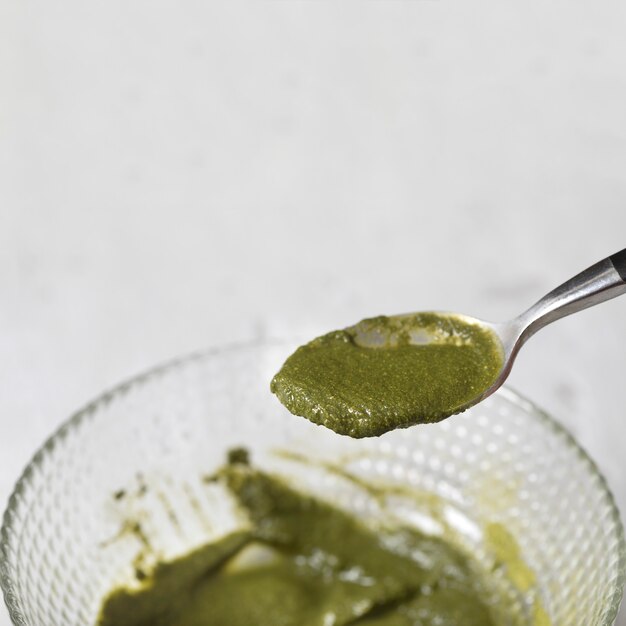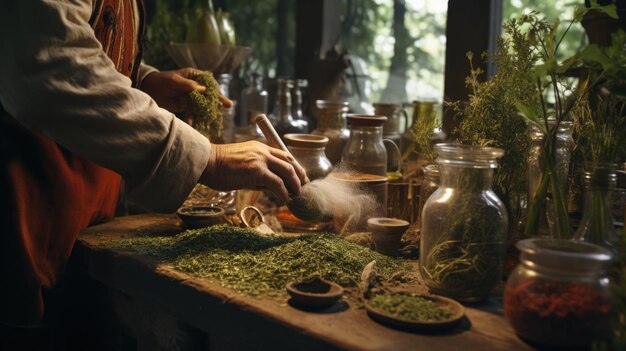आयुर्वेदिक डॉक्टर से प्रश्न पूछें और निःशुल्क या भुगतान मोड में अपनी चिंता की समस्या पर ऑनलाइन परामर्श प्राप्त करें। 2,000 से अधिक अनुभवी डॉक्टर हमारी साइट पर काम करते हैं और आपके प्रश्नों का इंतजार करते हैं और उपयोगकर्ताओं को उनकी स्वास्थ्य समस्याओं को हल करने में प्रतिदिन मदद करते हैं।
अभी हमारे स्टोर में खरीदें
Sthanika Chikitsa – Ayurvedic Local Therapies for Targeted Healing

Introduction to Sthanika Chikitsa and Yoni Prakshalana
Sthanika Chikitsa, also referred to as local therapy in Ayurveda, focuses on addressing localized health issues through targeted interventions. One such practice within Sthanika Chikitsa is Yoni Prakshalana, which refers to the cleansing and purification of the vagina. This ancient Ayurvedic procedure has been prescribed by classical Ayurvedic Acharyas to promote vaginal health, hygiene, and overall well-being for women.
The process of Yoni Prakshalana is particularly important in the context of maintaining a balanced Dosha (Vata, Pitta, Kapha) in the reproductive system. In Ayurveda, it is believed that imbalances in these doshas can lead to various gynecological issues such as infections, dryness, and discomfort. Yoni Prakshalana is an essential part of Ayurvedic women's health practices, aimed at addressing these imbalances through natural, non-invasive techniques.
Historical Roots & Ayurvedic Significance
In Ayurvedic medicine, the practice of Yoni Prakshalana is considered an integral aspect of women's health care. It is mentioned in several ancient Ayurvedic texts, including Sushruta Samhita and Ashtanga Hridayam, which emphasize the importance of cleansing and nourishing the female reproductive system. According to these texts, vaginal health is not only crucial for physical well-being but also plays a significant role in maintaining a balanced mind and emotions. The Acharyas described various methods to purify the yoni (vagina) using medicated herbal solutions to treat conditions like vaginal infections, menstrual irregularities, and general discomfort.
The belief is that cleansing the yoni regularly helps maintain proper hygiene, balance the reproductive system, and prevent the accumulation of toxins (Ama). Yoni Prakshalana also promotes the proper flow of apana vayu, a vital energy that governs the elimination process and reproductive health in Ayurvedic physiology.
Methods of Yoni Prakshalana
1. Herbal Cleansing Solutions
Yoni Prakshalana is typically performed using herbal formulations that are gentle yet effective for cleansing. These solutions may contain herbs known for their antimicrobial, soothing, and balancing properties. Some commonly used herbs in the preparation of Yoni Prakshalana solutions include:
- Neem (Azadirachta indica): Known for its antibacterial, antifungal, and anti-inflammatory properties, Neem helps cleanse and purify the vaginal area, reducing the risk of infections.
- Turmeric (Curcuma longa): A natural antiseptic and anti-inflammatory agent, turmeric helps prevent infections and soothes any irritation.
- Guduchi (Tinospora cordifolia): This herb strengthens the immune system and supports detoxification.
- Ashoka (Saraca asoca): Traditionally used to support reproductive health and balance female hormones.
- Lodhra (Symplocos racemosa): Helps tone and cleanse the reproductive organs while reducing excessive discharge.
These herbs are typically boiled or steeped in water to create a medicated solution that can be used for the external washing or irrigation of the vaginal area.
2. Vaginal Steaming (Yoni Swedana)
Another method used in Yoni Prakshalana is Yoni Swedana, which involves the application of herbal steam to the vaginal area. The steam is generated from boiling water infused with medicinal herbs such as Saffron, Rose petals, and Eucalyptus. This process helps open the pores, cleanse the vaginal canal, and improve blood circulation, thereby promoting overall reproductive health.
3. Douching with Herbal Solutions
Douching, a method where a medicated solution is gently flushed into the vagina, is another approach within Yoni Prakshalana. Herbal solutions, typically made from Sida cordifolia or Triphala, are used to flush out toxins and cleanse the area.
4. Ayurvedic Oils and Pastes
Local application of Ayurvedic oils and pastas made from herbs like Sesame oil, Coconut oil, or Moringa oil may also be part of the cleansing process. These oils not only cleanse but also provide nourishment and hydration to the delicate tissues of the vaginal area.
5. Lifestyle and Dietary Modifications
In addition to the external applications, Yoni Prakshalana includes internal care, such as the consumption of foods that promote reproductive health. Ayurveda recommends a balanced diet rich in antioxidants, vitamins, and minerals, with particular emphasis on ghee, whole grains, and fresh fruits and vegetables. These foods support the body's detoxification process and help maintain a healthy balance of the reproductive system.
Benefits of Yoni Prakshalana
1. Maintains Vaginal Hygiene
Yoni Prakshalana is particularly beneficial for maintaining proper vaginal hygiene. It helps cleanse the vaginal canal, preventing infections and irritations caused by bacteria, fungi, or excessive discharge. The herbal solutions used in the process are natural and non-toxic, ensuring a gentle yet effective cleanse.
2. Balances Doshas
By promoting the flow of apana vayu and balancing Vata, Pitta, and Kapha, Yoni Prakshalana helps restore harmony to the female reproductive system. It can address issues related to irregular menstruation, PMS symptoms, or postmenopausal discomfort by calming the doshic imbalances that affect the reproductive organs.
3. Detoxifies the Reproductive System
Regular use of Yoni Prakshalana helps remove accumulated toxins (Ama) from the vaginal area, promoting the health of the uterus, ovaries, and fallopian tubes. Detoxifying the reproductive system is essential for preventing future reproductive health concerns and promoting overall well-being.
4. Alleviates Menstrual Discomfort
Yoni Prakshalana is also recommended for women experiencing painful menstruation. The herbs used in the cleansing process have anti-inflammatory properties that help reduce cramping, bloating, and discomfort during the menstrual cycle.
5. Enhances Fertility
In Ayurveda, maintaining a clean and balanced reproductive system is vital for fertility. Yoni Prakshalana promotes healthy blood circulation to the reproductive organs, supporting hormonal balance and enhancing fertility. It is often recommended for women trying to conceive as part of a holistic approach to fertility.
How to Perform Yoni Prakshalana Safely
While Yoni Prakshalana is an effective treatment, it is important to approach it with caution and follow proper guidelines:
- Consult an Ayurvedic Practitioner: Before starting any type of local therapy, it is important to consult a qualified Ayurvedic practitioner who can guide you on the appropriate herbs, dosage, and frequency based on your individual constitution (Prakriti) and health condition.
- Use Safe and Pure Ingredients: Ensure that the herbal solutions or oils used for Yoni Prakshalana are free from chemicals, preservatives, or synthetic additives.
- Avoid Overuse: While Yoni Prakshalana is beneficial, overuse or improper use can cause irritation. It is recommended to perform the therapy in moderation and as advised by a practitioner.
- Maintain Overall Hygiene: In addition to the internal cleansing, maintaining overall genital hygiene through regular washing with lukewarm water is essential to avoid infections.
Frequently Asked Questions for Yoni Prakshalana
What is Yoni Prakshalana in Ayurveda?
Yoni Prakshalana is a traditional Ayurvedic therapy used for cleansing and purifying the vagina. It involves the use of herbal solutions, vaginal steaming, and other local treatments to maintain vaginal health, balance doshas, and detoxify the reproductive system.
How does Yoni Prakshalana help maintain vaginal hygiene?
Yoni Prakshalana helps maintain vaginal hygiene by cleansing the vaginal canal, preventing infections, and reducing the buildup of toxins. The herbal solutions used have antimicrobial and anti-inflammatory properties that promote a healthy vaginal environment.
What herbs are used in Yoni Prakshalana?
Common herbs used in Yoni Prakshalana include Neem, Turmeric, Guduchi, Amla, Karela, and Ashoka. These herbs have antibacterial, antifungal, and anti-inflammatory properties, which help cleanse, soothe, and balance the vaginal area.
Is Yoni Prakshalana safe for all women?
While Yoni Prakshalana is generally safe, it is essential to consult an Ayurvedic practitioner before starting the treatment, especially for women who are pregnant, have certain gynecological conditions, or experience frequent infections.
Can Yoni Prakshalana help with menstrual discomfort?
Yes, Yoni Prakshalana can help alleviate menstrual discomfort such as cramps and bloating by reducing inflammation and promoting relaxation of the pelvic area. The herbs used in this therapy can also help balance hormonal levels.
How often should Yoni Prakshalana be performed?
The frequency of Yoni Prakshalana depends on individual needs and health conditions. Typically, it can be performed once a month, but it is best to follow the guidance of a qualified Ayurvedic practitioner.
Where can I learn more about Yoni Prakshalana?
To learn more about Yoni Prakshalana, it is recommended to consult with an Ayurvedic practitioner who specializes in women's health. Ayurvedic textbooks and research articles may also provide detailed information on the practice.
Conclusion & Expert Insights
Yoni Prakshalana is a powerful and holistic approach to maintaining vaginal health in Ayurveda. By regularly cleansing the reproductive system, this treatment promotes optimal hygiene, balances the doshas, and supports overall reproductive health. As part of a comprehensive health regimen, Yoni Prakshalana can help women maintain vitality, alleviate discomfort, and enhance fertility. Always consult with an experienced Ayurvedic practitioner for safe and personalized care.
References & Further Reading
- Lad, V. (2002). Ayurveda: The Science of Self-Healing.
- Sushruta Samhita: The Surgical Compendium of Ayurveda.
- Ashtanga Hridayam: A Comprehensive Guide to Ayurveda.
- National Institute of Ayurveda:
यह लेख वर्तमान योग्य विशेषज्ञों द्वारा जाँचा गया है Dr Sujal Patil और इसे साइट के उपयोगकर्ताओं के लिए सूचना का एक विश्वसनीय स्रोत माना जा सकता है।



